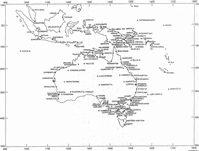


RAAF Meteorological Service
Foreword
Introduction
Chapter 1: The Weather Factor in Warfare
Chapter 2: Establishing and Developing the RAAF Directorate of Met. Services (D.Met.S)
Chapter 3: Recruiting and Training of Personnel
Chapter 4: Meteorology in Aviation
Chapter 5: The Met. Retreating
Chapter 6: The Met. Advancing
Chapter 7: The Met With the Army and the Navy
Chapter 8: Divisional Offices of the Bureau of Meteorology During the War
Chapter 9: Research and Instrumental Development
Chapter 10: The End, Aftermath, and Beyond
Appendix 1
Appendix 2
Appendix 3
Appendix 4
References
Index
Search
Help
Contact us

I am grateful for the facilities made available to me at the Head Office of the Bureau of Meteorology where for some three weeks, whilst researching and interviewing, I was provided with office space, a telephone, and the generous aid of the Director, Dr John Zillman, and his staff. The library staff also searched out valuable information. In Sydney, the then Regional Director of the Bureau of Meteorology, Mr Malcolm Lamond, is well remembered for his courtesy and attention.
Three former Met. officers (now retired)—Messrs V. J. Bahr, W. J. Gibbs and A. K. Hannay spent considerable personal time and effort in providing me with information, and in making preliminary arrangements for my contacts with other people and places.
To Misses Kathleen Atherton, MBE (Brisbane), Nan Gaby (Sydney Met. Bureau), Mrs Florence Hall (Bendigo), and Mrs Dulcie Wilkinson (Melbourne), I am grateful for their contributions which enabled me to include something about the meteorological personnel of the Women's Australian Auxiliary Air Force (WAAAF).
My only regret was that a complete list of Meteorological Assistants and Meteorological Charters was nowhere available—and hence, could not be included. Hence the list of these shown in Appendix 3 is, unfortunately, not comprehensive.
This story emerges at a time when the surviving members of Australia's World War II armed forces have become senior citizens. Many have passed on since 1945—even some who have contributed to this account. As our nation's bicentenary approaches, it seems fitting to keep alive the memory of those who have served our country well. This account then, is dedicated to the men and women of the RAAF Met. Service.

To gain a clearer picture of the role played by the RAAF Met. Service during World War II, it is helpful to review briefly the development of aviation meteorological services during the period 1934 to 1939.
People in Bright Sparcs - Bahr, Victor John; Hannay, Alexander Keith (Keith); Zillman, John William
 |
Bureau of Meteorology |  |
© Online Edition Australian Science and Technology Heritage Centre and Bureau of Meteorology 2001
Published by Australian Science and Technology Heritage Centre, using the Web Academic Resource Publisher
http://www.austehc.unimelb.edu.au/fam/0207.html